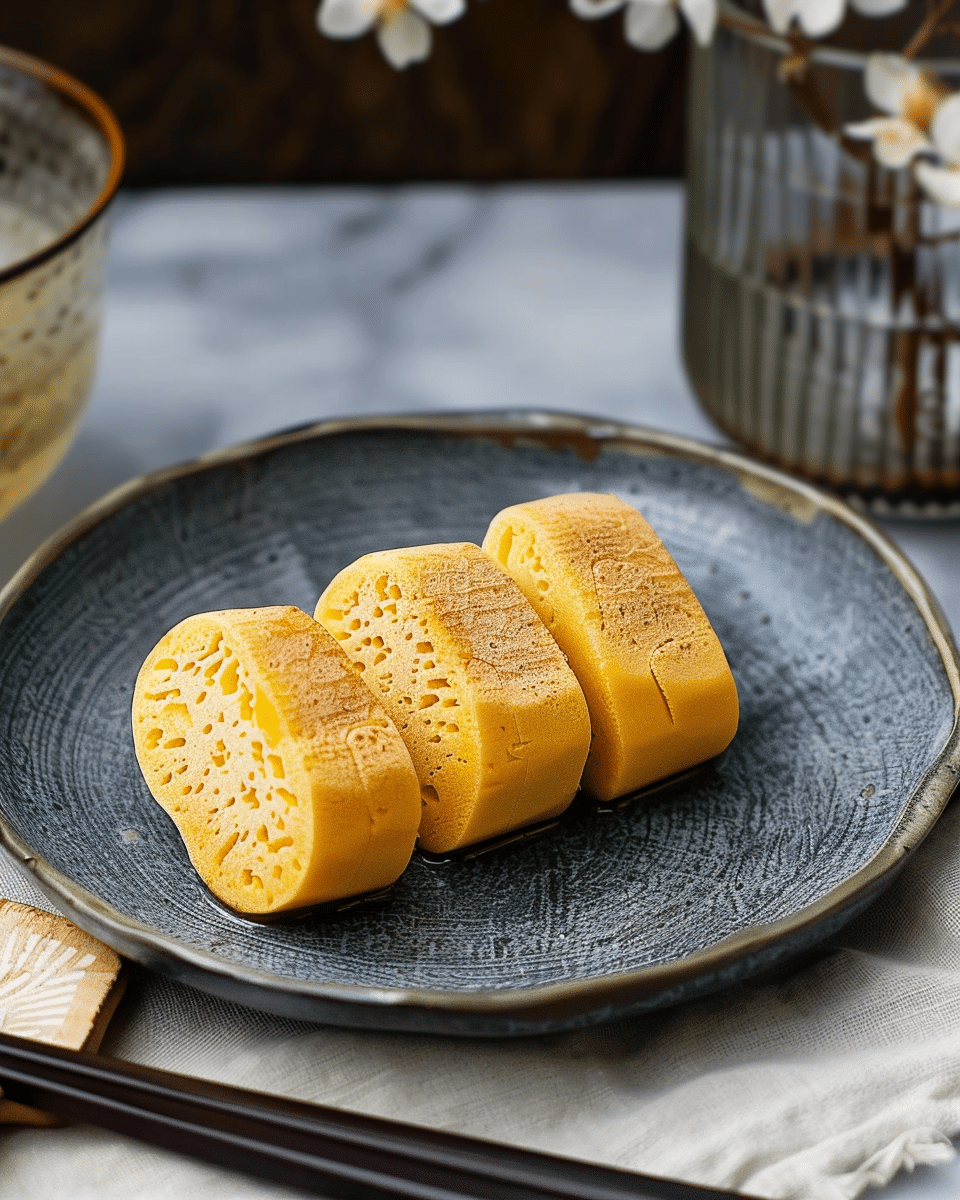Japanese Tamago, also known as Tamagoyaki, is a slightly sweet rolled omelet that’s a staple in Japanese cuisine. Soft, delicate, and layered, it’s often enjoyed as part of a traditional breakfast, in bento boxes, or as sushi topping. Made with dashi stock, soy sauce, and sugar, Tamago is savory with a touch of sweetness, making it a well-balanced and versatile dish.
Why You’ll Love This Recipe
- A traditional Japanese recipe that’s simple yet elegant
- Sweet and savory flavor profile with a fluffy texture
- Perfect for breakfast, sushi, or as a side dish
- Made with just a handful of ingredients
- Can be prepared in under 15 minutes

Ingredients
(Tip: You’ll find the full list of ingredients and measurements in the recipe card below.)
4 eggs
1/4 cup prepared dashi stock
1 tablespoon white sugar
1/2 teaspoon soy sauce
1/2 teaspoon vegetable oil, or more as needed
Directions
- In a medium bowl, beat eggs until smooth. Whisk in dashi stock, sugar, and soy sauce until sugar dissolves.
- Lightly oil a nonstick skillet and heat over medium heat.
- Pour a thin layer of egg mixture into the skillet, swirling to coat the bottom. Cook for about 1 minute, until the bottom is set but the top is slightly soft.
- Using a spatula, carefully lift one edge and roll up the egg layer.
- Push the rolled omelet to one side of the skillet. Oil the pan lightly again.
- Pour in another thin layer of egg mixture, lifting the roll slightly so the new layer flows underneath. Cook briefly, then roll the first omelet into the new layer.
- Repeat with the remaining egg mixture, oiling the pan as needed.
- Remove the rolled omelet from the pan and place on a serving platter.
- Slice into 6 equal pieces and serve warm or at room temperature.
Servings and timing
This recipe serves 2–3 people.
- Prep time: 5 minutes
- Cook time: 10 minutes
- Total time: 15 minutes
Variations
- Add finely chopped scallions or nori strips for extra flavor.
- Make it less sweet by reducing the sugar to 1/2 tablespoon.
- Try a Tamago sushi version by placing slices on top of sushi rice and securing with nori strips.
- Add a pinch of salt for a more savory flavor profile.
Storage/Reheating
- Store leftovers in an airtight container in the refrigerator for up to 2 days.
- Serve cold straight from the fridge, as it’s often enjoyed in bento boxes.
- Reheat gently in a skillet or microwave for 20–30 seconds, though texture is best when fresh.
- Not recommended for freezing, as eggs can become rubbery.

FAQs
What is Tamago made of?
It’s made of eggs, dashi stock, soy sauce, and sugar, giving it a sweet and savory taste.
Do I need a special Tamagoyaki pan?
A rectangular Tamago pan makes rolling easier, but a regular round nonstick skillet works too.
Can I make Tamago without dashi?
Yes, you can substitute water or chicken broth, though it won’t have the same depth of flavor.
Why is my Tamago breaking when I roll it?
The pan may be too hot, or the egg layer is too thick. Keep layers thin and cook on medium heat.
Can I make Tamago ahead of time?
Yes, it can be refrigerated and served cold, making it great for bento boxes.
Is Tamago served hot or cold?
It can be enjoyed either warm or cold.
How thin should each egg layer be?
Each layer should be thin enough to cook quickly but strong enough to roll, about 1–2 tablespoons of egg mixture per layer.
What can I serve Tamago with?
It pairs well with rice, miso soup, sushi, or as a side dish in a Japanese meal.
Is Tamago gluten-free?
Yes, as long as you use gluten-free soy sauce.
Conclusion
Japanese Tamago egg is a light, flavorful rolled omelet that’s both simple and versatile. With its sweet and savory taste, it’s perfect for breakfast, sushi, or a quick side dish. Whether you’re making it in a traditional rectangular pan or a regular skillet, this recipe is a delicious way to enjoy a classic Japanese favorite at home.
Print
Japanese Tamago Egg
- Total Time: 15 mins
- Yield: 2–3 servings
- Diet: Gluten Free
Description
Japanese Tamago, or Tamagoyaki, is a delicate rolled omelet with a balance of sweet and savory flavors. Made with eggs, dashi, soy sauce, and sugar, this traditional Japanese dish is fluffy, layered, and versatile—perfect for breakfast, sushi, or as a side dish. Ready in just 15 minutes, it’s an authentic and elegant recipe that showcases classic Japanese flavors.
Ingredients
4 eggs
1/4 cup prepared dashi stock
1 tablespoon white sugar
1/2 teaspoon soy sauce
1/2 teaspoon vegetable oil, or more as needed
Instructions
- In a bowl, beat eggs until smooth. Whisk in dashi stock, sugar, and soy sauce until sugar dissolves.
- Lightly oil a nonstick skillet and heat over medium heat.
- Pour a thin layer of egg mixture into the skillet, swirling to coat the bottom. Cook for about 1 minute until bottom is set but top is slightly soft.
- Using a spatula, carefully lift one edge and roll up the egg layer.
- Push the rolled omelet to one side. Lightly oil the pan again.
- Pour in another thin layer of egg mixture, lifting the roll slightly so it flows underneath. Cook briefly, then roll the omelet into the new layer.
- Repeat until all egg mixture is used, oiling pan as needed.
- Remove omelet from skillet and place on a serving platter.
- Slice into 6 pieces and serve warm or at room temperature.
Notes
- A rectangular Tamagoyaki pan makes rolling easier, but a round nonstick pan works fine.
- Keep layers thin to avoid breaking when rolling.
- Serve warm or chilled in bento boxes.
- Best eaten fresh, but can be refrigerated up to 2 days.
- Prep Time: 5 mins
- Cook Time: 10 mins
- Category: Breakfast
- Method: Stovetop
- Cuisine: Japanese
Nutrition
- Serving Size: 1/3 recipe
- Calories: 110
- Sugar: 3g
- Sodium: 160mg
- Fat: 7g
- Saturated Fat: 2g
- Unsaturated Fat: 4g
- Trans Fat: 0g
- Carbohydrates: 4g
- Fiber: 0g
- Protein: 9g
- Cholesterol: 210mg







